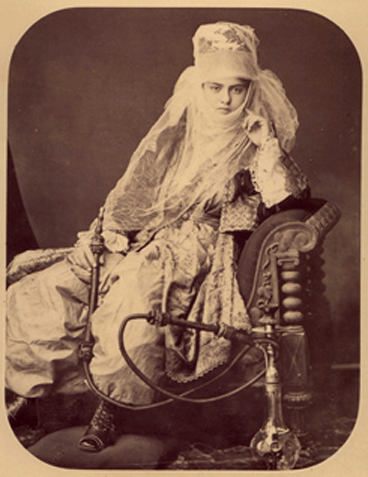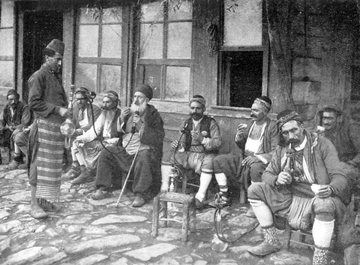
Hooked on Hookah, 1909
No, this is not another post about terrorism, nor the violent protests following the recent Iranian election, nor more reports of suicide bombs in hotel lobbies. The smoke from these tragedies is not about to disappear any time soon. The smoke I am talking about is from the tobacco industry. Newsweek (July 27 issue) provides a breakdown of smokers worldwide. While China leads all populations with almost 334 million smokers (32% of the overall population), they are actually lower percentage wise than Turkey with its 19 million users, accounting for 36% of the population. Other Middle Eastern countries surveyed fare a bit better than the United States (24% of the population) with 21% (28 million users) in Pakistan, 17.6% (9 million users) in Iran and only 14.2% (2.4 million users) in Iraq. I suspect even these numbers are under reported, given the ubiquity of cigarettes in the region. Health warnings or not, tobacco is still sultan in the Middle East and indeed the entire world. The Newsweek article notes that this year alone five trillion cigarettes will be produced. And for a sober thought, China has more smokers hooked on nicotine than the entire population of the United States. Around the world some 57 million people die each year from complications due to smoking. But shisha clubs are on the rise.
So how did this habit spread so far and wide? After all, tobacco is a New World crop, appearing in Arabic herbals as a medicant by the end of the 16th century. In much of the region the leaves were either chewed or filtered through the water pipe, a popular method now even in the United States. There were those who saw value in the properties of the plant, but many who thought it a weed straight out of hell. After all, as some scholars noted, had not the Prophet Muhammad warned that in the last days people would actually drink smoke (yushrib al-dukhÄn).
If you want to learn more about the spread of tobacco in the Ottoman Empire, I recommend a fascinating article by James Grehan, published in the American Historical Review in 2006. Here is how the article begins:
In April 1699, an unusual disturbance broke out in the streets of Cairo. As part of the annual pilgrimage caravan, which escorted Muslim pilgrims through the Sinai Desert to the holy cities of Arabia, a solemn procession was conveying a new silk covering destined for the Ka‘ba or Sacred Shrine, in Mecca. Among the most notable participants were a group of North Africans, who created an uproar as they moved through the streets. Fired by religious zeal, they insisted on applying their own brand of Islamic morality to the crowd of onlookers. In choosing targets for chastisement, they were very specific, beating all the people whom they found smoking tobacco. As the tumult grew, they made their decisive mistake. Seizing a member of a local paramilitary group, they smashed his pipe, and during the ensuing quarrel, went so far as to hit him over the head. The crowd had apparently seen enough. Even as soldiers rushed to the scene, the ’people of the marketplace’ took matters into their own hands and began attacking the North Africans. The violence ended only with the arrival of a Janissary officer, who hauled the North Africans off to prison.
Looking back on this incident from a very different time and place, with our own concerns and passions about tobacco, it is hard not to be struck by the deep emotions that smoking, even then, was capable of eliciting. Walking through Middle Eastern towns today, one could never imagine that such struggles ever took place. Nearly everyone has now accepted smoking as a public freedom. Few people would dream of condemning it as a moral scourge, or of banishing it from the streets and markets. If smokers today hear medical warnings about the dangers of tobacco, they remain oblivious to the acrimony that it once unleashed. This tolerant consensus did not emerge all at once. After its first arrival in the Ottoman Middle East at the end of the sixteenth century, tobacco would ignite intense debates about its legality and morality. the altercation in the streets of Cairo highlights these divisions in opinion. Invoking religion and morality, the rowdy North Africans were determined to put an end ot smoking, and felt justified in using extreme measures. On the other side, the ‘people of the marketplace’ completely denied this presumptive right to intervene in the affairs of others or to act independently on behalf of religion. To make their point, both camps were willing to come to blows.
Excerpt from Grehan, James. 2006. Smoking and “Early Modern†Sociability: The Great Tobacco Debate in the Ottoman Middle East (Seventeenth to Eighteenth Centuries). American Historical Review 115(5):1352-1377. For the rest of the article, click here.

For early photographs and artwork of the waterpipe, click here.
Daniel Martin Varisco